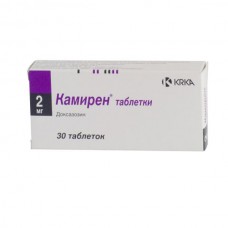Expiration date: 03/2026
Structure and Composition:
1 tablet contains doxazosin 1, 2 or 4 mg in blisters of 10 pcs., In a cardboard unit 2 or 3 packs.
Pharmachologic effect:
Selectively blocks postsynaptic alpha1-adrenergic receptors. Decreases round, total cholesterol, LDL, and triglycerides and increased HDL cholesterol content in serum. It prevents atherosclerosis and CHD, inhibits platelet aggregation. Decreases in left ventricular mass (for long-term treatment). Prevents contraction of smooth muscles of the urethra and the upper part of the muscles of the prostate, it helps to alleviate urination and elimination dizuricheskih symptoms associated with benign prostatic hyperplasia.
Pharmacokinetics:
Well absorbed from the gastrointestinal tract, the Cmax is achieved in 1.5-3 hours. Almost entirely associated with plasma proteins, it is metabolized in the liver. T1 / 2 -. 16-22 hours is derived, including as metabolites, mainly in the feces, at least 10% - urine.
Clinical Pharmacology:
Hypotensive effect is most pronounced for 2-6 hours after drug administration and is continued for 24 hours. The maximum effect is achieved after several weeks of continuous administration. The effect on normal blood pressure slightly. It can be used in patients with renal insufficiency, chronic obstructive pulmonary disease, peripheral arterial disease, gout and diabetes mellitus type 2.
Indications:
Hypertension mild or moderate in severity (monotherapy or in combination with other antihypertensive drugs), benign prostatic hyperplasia (symptomatic treatment).
Contraindications:
Hypersensitivity, including other derivative quinazoline (prazosin, terazosin), or to other components of the drug, obstruction of the digestive tract or esophagus, narrowing of the gastrointestinal tract of any degree, children's age.
Application of pregnancy and breastfeeding:
Perhaps if the expected effect of therapy outweighs the potential risk to the fetus. At the time of treatment should stop breastfeeding.
Side effect:
Cardio-vascular system and blood (blood, hemostasis): arterial hypotension (especially at the beginning of treatment and when increasing the dose of the drug during the transition from a recumbent or seated position to a standing position), very rarely - worsening of angina, myocardial infarction, cerebrovascular stroke, irregular heartbeat (but it has not been established that the cause is the use of doxazosin) thrombocytopenia.
From the respiratory system: nasal congestion or runny nose, flu-like symptoms, bronchitis, shortness of breath.
From the digestive tract: rarely - nausea, cholestasis, hepatitis, liver function violation.
From the musculoskeletal system: muscle weakness.
From the nervous system and sensory organs: dizziness, headache, fatigue, drowsiness.
For the skin: very rarely - skin rashes, purpura.
Other: hematuria, epistaxis, swelling of the ankles and legs.
Drug Interactions:
Effect increase beta-blockers, diuretics, calcium channel blockers, ACE inhibitors, nitrates, anesthetics, tricyclic antidepressants and alcohol.
Dosage and administration:
Inside, regardless of meals.
Arterial hypertension and benign prostatic hyperplasia in patients with hypertension: an initial dose (in the evening before going to bed) - 1 mg per day with gradual increase to 2, 4 and 8 mg 1 time a day at intervals of 1-2 weeks. The usual daily dose - 2-8 mg, the maximum - 16 mg.
Benign prostatic hyperplasia in patients with normal blood pressure: initial dose (in the evening before bedtime)
1 mg / day, gradually increasing to 2, 4 and 8 mg 1 time per day (range - 1-2 weeks). The average daily dose - 2-4 mg, maximum - 8 mg.
Overdose:
Symptoms: hypotension, dizziness, fainting.
Treatment: gastric lavage, administration of activated charcoal, laxatives, norepinephrine hemodialysis ineffective.
Precautionary measures:
To use caution in patients with hepatic insufficiency. In order to avoid orthostatic hypotension, treatment should start with a dose of 1 mg in the evening before bedtime. Care must be taken when changing from a lying or sitting position to a standing position.
Before the treatment of benign prostatic hyperplasia patients should be evaluated by a urologist. Care should be taken while taking drugs that affect hepatic metabolism. Should not be used during the drivers of vehicles and people skills relate to the high concentration of attention.



